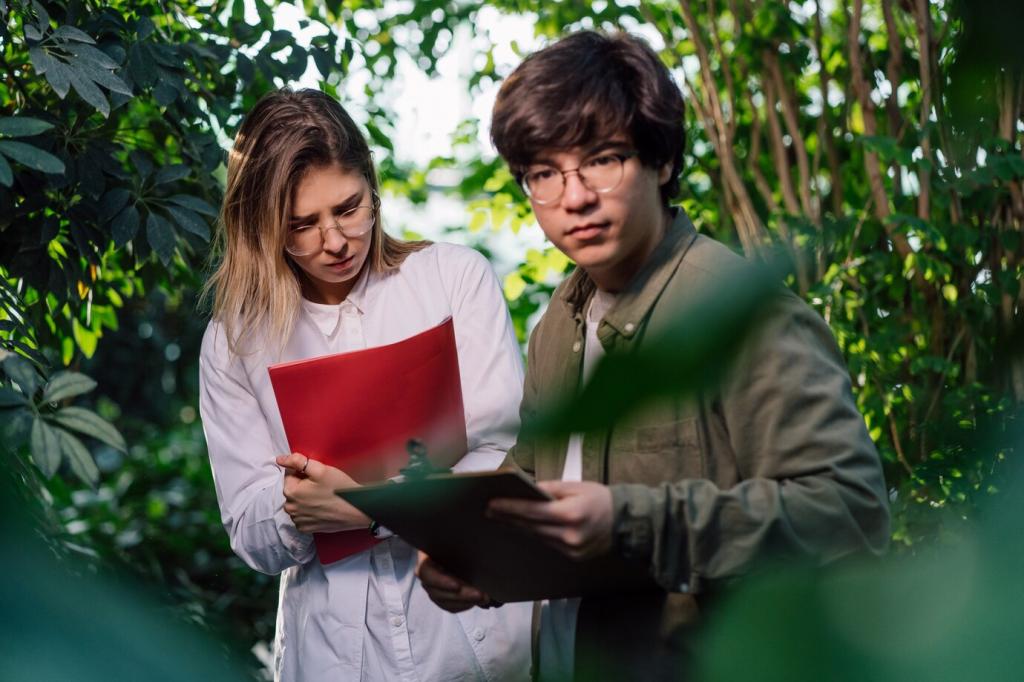Innovative Approaches to Biophilic Architecture
Biophilic architecture represents a dynamic intersection between the built environment and the natural world, cultivating spaces that foster human well-being by reconnecting us with nature. As urbanization accelerates, architects and designers are leveraging inventive strategies to integrate natural elements into buildings, transforming how we interact with our surroundings. This web page explores groundbreaking developments in biophilic design, highlighting the ways architects are adopting innovative materials, technologies, spatial strategies, and philosophies to create healthier, more inspiring, and sustainable spaces for people across the globe.

Dynamic Plant Selection for Climatic Adaptation
Incorporating dynamic plant species that respond to seasonal and climatic variations is a key innovation within living façades. By carefully studying regional biodiversity and microclimates, designers select plant communities that flourish year-round, shifting in appearance and function throughout the seasons. These adaptive green walls naturally contribute to energy efficiency by providing shade in summer, insulation in winter, and serving as air filters that improve indoor air quality. This thoughtful selection process also fosters ecological resilience, increasing resistance to pests and environmental stressors, ensuring that living façades remain robust, sustainable, and visually engaging over time.

Modular Green Wall Systems for Customization
Modular green wall systems provide unprecedented flexibility in designing biophilic architecture. By using prefabricated panels or units that can be easily installed, replaced, or reconfigured, architects can tailor the vertical garden’s scale, pattern, and botanical composition to suit a variety of spaces and aesthetic intentions. These systems make it possible to introduce greenery to areas previously deemed unsuitable, such as high-rise buildings or interiors with limited sunlight. Moreover, the modularity simplifies maintenance and allows for ongoing experimentation with plant arrangements, ensuring that the green wall evolves in response to building occupants’ needs and desires.

Integration with Water Management Solutions
The integration of vertical gardens with advanced water management technologies addresses both ecological sustainability and practical maintenance challenges. Automated irrigation systems, rainwater harvesting, and smart sensors ensure that plants receive optimal hydration with minimal waste. Designing façades to retain and filter stormwater mitigates urban runoff and supports broader sustainability goals. This synergy of green infrastructure and water management represents a comprehensive approach that enhances building performance, contributes to urban resilience, and reinforces the restorative connection between natural cycles and the built environment.

Nature-Inspired Spatial Layouts
Drawing inspiration from the organic patterns and flow of natural environments, architects are moving away from rigid, rectilinear layouts towards fluid and adaptive spatial organizations. Curvilinear walls, meandering pathways, and organic partitions replicate the experience of moving through a forest or along a riverbank, creating a sense of exploration and discovery. Such designs foster a calming ambiance, helping to reduce stress and promote a greater sense of belonging within a space. The result is a harmonious environment that encourages both solitude and collaboration, shaped by the innate preferences human beings have developed through millennia of living in nature.

Maximizing Daylight and Natural Ventilation
Daylight and fresh air are vital components of biophilic interiors, and innovative architectural strategies are making these resources more abundant than ever before. Large windows, skylights, and clerestories are positioned to harness the sun’s movement, providing dynamic lighting throughout the day while reducing reliance on artificial sources. Operable windows, ventilation shafts, and green courtyards are integrated to facilitate natural airflow, improving comfort and indoor air quality. These strategies are meticulously balanced to minimize energy consumption, support circadian rhythms, and create energizing spaces that contribute to mental clarity and overall wellness.
Previous
Next
Technological Innovations in Biophilic Integration

Smart Building Systems for Nature-Based Metrics
The integration of smart systems allows buildings to monitor and optimize environmental conditions in real time. Embedded sensors track factors such as light levels, humidity, air quality, and plant health, automatically adjusting systems to support both occupant comfort and ecological performance. Data visualization platforms encourage building users to engage with natural cycles, fostering a sense of stewardship. As these technologies evolve, they help architects quantify the benefits of biophilic design, leveraging evidence-based practices to continually refine and maximize the wellness and environmental outcomes of their projects.

Augmented and Mixed Reality Nature Experiences
The use of augmented reality (AR) and mixed reality (MR) technologies extends the reach of biophilic architecture beyond physical constraints. By overlaying digital flora, fauna, and natural phenomena onto real-world environments, designers create immersive experiences that evoke a sense of connection to remote or endangered habitats. These virtual interventions can be tailored to changing seasons or personal preferences, providing a highly customizable and engaging encounter with nature. As digital tools become more intuitive, they offer powerful opportunities for environmental education, fostering empathy and awareness even in urban contexts where access to wilderness is limited.

Robotics and Automated Plant Care
Automation technologies are revolutionizing the maintenance of biophilic elements in buildings, ensuring that living systems remain healthy and robust with minimal human intervention. Robotics can manage tasks such as irrigation, pruning, and plant health monitoring, reducing labor costs and increasing precision. Automated systems can react quickly to changes in environmental conditions, preventing pest outbreaks or nutrient imbalances. This reliability and efficiency are critical in high-density urban settings, where the scale and complexity of green infrastructure demand innovative care solutions.
Multisensory Biophilic Experiences
Acoustic Design Incorporating Natural Soundscapes
Acoustic design plays an essential role in crafting soothing environments that reduce the stress and fatigue of urban life. By integrating features such as water fountains, bird-attracting landscaping, and acoustic panels that mimic the gentle rustle of foliage, architects introduce calming natural soundscapes into buildings. These auditory cues can mask unwanted noise pollution and provide cognitive restoration, helping occupants feel more relaxed and focused. Careful selection and placement of materials amplify or dampen specific frequencies, resulting in tailored sound environments that authentically recreate the tranquility of nature indoors.
Fragrance and Olfactory Stimulation Through Living Plants
Scent is a powerful trigger for memory and emotion, and biophilic architecture increasingly leverages olfactory cues to evoke nature. Designers select aromatic plants and integrate living walls or gardens to infuse interior spaces with subtle, refreshing fragrances reminiscent of forests, meadows, or herbal groves. In addition to heightening sensory pleasure, these scents can improve mood, reduce anxiety, and even support alertness or relaxation, depending on the environment’s function. By blending botanical selections with cutting-edge ventilation and distribution technologies, architects deliver consistent and enjoyable olfactory experiences.
Haptic and Interactive Natural Installations
Inviting hands-on engagement, haptic design elements such as textured stone pathways, living moss walls, and movable planters elevate the sensory impact of biophilic spaces. Tactile exploration deepens users’ awareness and appreciation of environmental variation—temperature, moisture, and surface give sensations not captured visually. Interactive features, like kinetic art or plant-responsive installations, empower people to shape their surroundings actively, cultivating agency and reinforcing the sense of being a participant in, rather than a mere observer of, natural processes.

Urban Biophilia and Community-Focused Spaces
01
Urban biophilic architecture increasingly emphasizes the creation of continuous green corridors that stitch together parks, plazas, and open spaces throughout a city. These ecological pathways support local biodiversity by offering habitat and migratory routes for birds, insects, and small mammals. For residents, they provide safe, shaded routes for walking and cycling, promoting healthy lifestyles and daily encounters with nature. Thoughtful integration of native vegetation, water features, and gathering spaces transforms these corridors into living social infrastructure, connecting communities while simultaneously enhancing urban resilience to climate-related challenges.
02
Community gardens have emerged as vital nodes within the urban biophilic landscape, offering shared outdoor spaces where people can engage in gardening, learn about native plants, and participate in communal activities. These gardens provide fresh produce, contribute to food security, and offer hands-on opportunities for environmental stewardship. By designing these spaces to be accessible, inclusive, and adaptable to different cultural practices, architects foster social cohesion and intergenerational learning. The resulting sense of ownership and pride strengthens community bonds and cultivates a deeper connection between urban residents and the land.
03
Regenerative placemaking integrates ecological restoration with cultural expression, transforming underused urban sites into vibrant biophilic destinations that reflect the stories and aspirations of local communities. This process involves collaborating with residents, artists, and ecologists to uncover and celebrate the historical and natural context of each site. By weaving cultural narratives into green spaces—through native plantings, art installations, and gathering areas—regenerative placemaking reinforces a shared sense of place and motivates ongoing ecological stewardship. It represents the ultimate synthesis of biophilia and community, empowering cities to heal both people and their environments.

Previous slide
Next slide
Sustainable Material Innovation in Biophilic Architecture
Bio-Based Composites and Renewable Resources
Bio-based composites—materials derived from agricultural waste, fast-growing plants, or fungi—represent a growing frontier in sustainable construction. These materials have dramatically lower embodied carbon compared to conventional options, while often offering superior thermal, acoustic, and structural performance. Bamboo, hempcrete, mycelium panels, and other innovations are being used to create walls, floors, and furniture that are lightweight, strong, and biodegradable. Their renewable nature underlines the biophilic commitment to environmental stewardship and circularity, ensuring that architectural interventions support regenerative lifecycles.

